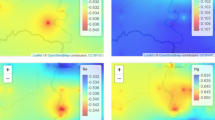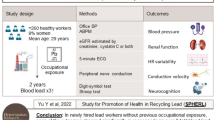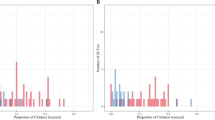Abstract
Childhood lead exposure has been shown to have a significant effect on neurodevelopment. Many of the biokinetics involved with lead biomarkers in children still remain unknown. Two hundred fifty (157 in the exposed group and 93 controls) children were enrolled in our study and lead exposed children returned for multiple visits for measurement of blood and bone lead and chelation treatment. We demonstrated that the correlation between blood and bone lead increased with subsequent visits. We calculated the blood lead half-life for 50 patients, and found a significant (p-value < 0.001) positive correlation with age. For ages 1–3 years (N = 17), the blood lead half-life was found to be 6.9 ± 4.0 days and for 3+ years it was found to be (N = 33) 19.3 ± 14.1 days. In conclusion, the turnover of lead in children is faster than in adults. Our results indicate that blood lead is a more acute biomarker of exposure than previously thought, which will impact studies of children’s health using blood lead as a biomarker.
This is a preview of subscription content, access via your institution
Access options
Subscribe to this journal
Receive 6 print issues and online access
$259.00 per year
only $43.17 per issue
Buy this article
- Purchase on Springer Link
- Instant access to full article PDF
Prices may be subject to local taxes which are calculated during checkout







Similar content being viewed by others
References
Canfield RL, Henderson CR, Cory-Slechta DA, Cox C, Jusko TA, Lanphear BP. Intellectual impairment in children with blood lead concentrations below 10 μg per deciliter. N Engl J Med. 2003;348:26.
Jusko TA, Henderson CR, Lanphear BP, Cory-Slechta DA, Parsons PJ, Canfield RL. Blood lead concentrations 10 microg/dL and child intelligence at 6 years of age. Environ Health Perspect. 2008;116:243–8.
Lanphear BP, Hornung R, Khoury J, Yolton K, Baghurst P, Bellinger DC, et al. Low-level environmental lead exposure and children’s intellectual function: an international pooled analysis. Environ Health Perspect. 2005;113:894–9.
Hong SB, Im MH, Kim JW, Park EJ, Shin MS, Kim BN, et al. Environmental lead exposure and attention deficit/hyperactivity disorder symptom domains in a community sample of South Korean school-age children. Environ Health Perspect. 2015;123:271–6.
Huang S, Hu H, Sánchez BN, Peterson KE, Ettinger AS, Lamadrid-Figueroa H, et al. Childhood blood lead levels and symptoms of attention deficit hyperactivity disorder (ADHD): a cross-sectional study of Mexican children. Environ Health Perspect. 2016;124:868–74.
Navas-Acien A, Guallar E, Silbergeld EK, Rothenberg SJ. Lead exposure and cardiovascular disease-a systematic review. Environ Health Perspect. 2007;115:472–82.
Pant N, Kumar G, Upadhyay AD, Patel DK, Gupta YK, Chaturvedi PK. Reproductive toxicity of lead, cadmium, and phthalate exposure in men. Environ Sci Pollut Res Int. 2014;21:11066–74.
Wu HM, Lin-Tan DT, Wang ML, Huang HY, Lee CL, Wang HS, et al. Lead level in seminal plasma may affect semen quality for men without occupational exposure to lead. Reprod Biol Endocrinol. 2012;10:91.
Boutwell BB, Nelson EJ, Emo B, Vaughn MG, Schootman M, Rosenfeld R, et al. The intersection of aggregate-level lead exposure and crime. Environ Res. 2016;148:79–85.
Wright JP, Dietrich KN, Ris MD, Hornung RW, Wessel SD, Lanphear BP, et al. Association of prenatal and childhood blood lead concentrations with criminal arrests in early adulthood. PLoS Med. 2008;5:e101.
National Toxicology Program N. NTP monograph on health effects of low-level lead. NTP Monogr. 2012;xiii, xv:148.
Specht AJ, Lin Y, Weisskopf M, Yan C, Hu H, Xu J, et al. XRF-measured bone lead (Pb) as a biomarker for Pb exposure and toxicity among children diagnosed with Pb poisoning. Biomarkers. 2016;21:347–52.
Nilsson U, Attewell R, Christoffersson JO, Schutz A, Ahlgren L, Skerfving S, et al. Kinetics of lead in bone and blood after end of occupational exposure. Pharmacol Toxicol. 1991;68(6):477–84.
EPA. US. Integrated science assessment (ISA) for lead (final report, Jul 2013). Washington, DC, EPA/600/R-10/075F: US Environmental Protection Agency; 2013.
Leggett RW. An age-specific kinetic model of lead metabolism in humans. Environ Health Perspect. 1993;101:18.
Manton WI, Angle CR, Stanek KL, Reese YR, Kuehnemann TJ. Acquisition and retention of lead by young children. Environ Res. 2000;82(1):60–80.
Duggan MJ. The uptake and excretion of lead by young children. Arch Environ Health. 1983;38:246–7.
Nie H. Studies in bone lead: a new cadmium-109 XRF measurement system. Modeling bone lead metabolism. Interpreting low concentration data. PhD thesis, McMaster Univ. (Canada) 2005.
Nie H, Chettle DR, Stronach IM, Arnold ML, Huang SB, McNeil FE, et al. A Study of MDL improvements for the in vivo measurement of lead in bone. Nucl Instrum Methods Phys Res B. 2004;213:4.
Specht AJ, Weisskopf M, Nie LH. Portable XRF technology to quantify Pb in bone in vivo. J Biomark. 2014;2014:9.
Nie H, Chettle D, Luo L, O’Meara J. Dosimetry study for a new in vivo X-ray fluorescence (XRF) bone lead measurement system. Nucl Instrum Methods Phys Res B. 2007;263:225–30.
Nie H, Sanchez S, Newton K, Grodzins L, Cleveland RO, Weisskopf MG. In vivo quantification of lead in bone with a portable x-ray fluorescence system—methodology and feasibility. Phys Med Biol. 2011;56(3):N39–51.
Liu KL. [Review of atomic spectroscopy]. Guang Pu Xue Yu Guang Pu Fen Xi. 2005;25:95–103.
Specker B, Johannsen N, Binkley T, Finn K. Total body bone mineral content and tibial cotrical bone measures in preschool children. J Bone Miner Res. 2001;16:2298–305.
Linderkamp O, Versmold HT, Riegel KP, Betke K. Estimation and prediction of blood volume in infants and children. Eur J Pediatr. 1977;125:227–34.
ICRP. Publication 70, basic anatomical and physiological data for use in radiological protection—the skeleton. Ann ICRP. 1995;25:1–80.
Ji JS, Power MC, Sparrow D, Spiro A 3rd, Hu H, Louis ED, et al. Lead exposure and tremor among older men: the VA normative aging study. Environ Health Perspect. 2015;123:445–50.
Rosen JF, Markowitz ME, Bijur PE, Jenks ST, Wielopolski L, Kalef-Ezra JA, et al. Sequential measurements of bone lead content by L X-ray fluorescence in CaNa2EDTA-treated lead-toxic children. Environ Health Perspect. 1991;93:271–7.
Pejović-Milić A, Brito JA, Gyorffy J, Chettle DR. Ultrasound measurements of overlying soft tissue thickness at four skeletal sites suitable for in vivo x-ray fluorescence. Med Phys. 2002;29:2687–91.
Acknowledgements
The authors would like to acknowledge Dr. Jian Xu and Yanfen Lin for their tremendous help on subject recruitment and data collection. The research could not be done without them. The authors would also like to thank the MOE-Shanghai Key Laboratory of Children’s Environmental Health at Xinhua Hospital affiliated to Shanghai Jiao Tong University School of Medicine for providing much needed support and resources for the project. This work was supported by the Nuclear Regulatory Commission (NRC) Faculty Development Grant NRC-HQ-84-14-G-0048, National Natural Science Foundation of China (81373016, 30901205), National Basic Research Program of China (“973” Program,2012CB525001), Shanghai Science and Technology Committee (124119a1400), Purdue Ross Fellowship, and Purdue US-China visiting scholar network travel grant program.
Author information
Authors and Affiliations
Corresponding author
Ethics declarations
Conflict of interest
The authors declare that they have no conflict of interest.
Electronic supplementary material
Rights and permissions
About this article
Cite this article
Specht, A.J., Weisskopf, M. & Nie, L.H. Childhood lead biokinetics and associations with age among a group of lead-poisoned children in China. J Expo Sci Environ Epidemiol 29, 416–423 (2019). https://doi.org/10.1038/s41370-018-0036-y
Received:
Revised:
Accepted:
Published:
Issue Date:
DOI: https://doi.org/10.1038/s41370-018-0036-y
Keywords
This article is cited by
-
Identifying periods of heightened susceptibility to lead exposure in relation to behavioral problems
Journal of Exposure Science & Environmental Epidemiology (2022)



